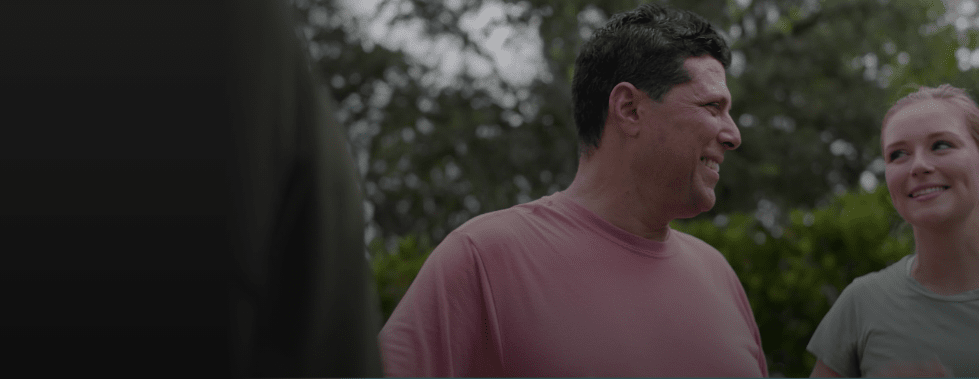These are stories from real patients who are sharing their experience living with CTCL and being treated with POTELIGEO. These videos represent their experiences at the time the video was recorded. Given the nature of CTCL, experiences may change over time. Individual results may vary. These patients have been compensated by Kyowa Kirin for their participation in these videos.
Jeffrey always seemed to be at war with his skin. As a child, he was prone to sunburns. His teen years brought severe acne and with it, debilitating shyness. By middle age, he thought he was through the worst of it when one day he noticed an odd rash on his chest while swimming.
His dermatologist thought it was atopic dermatitis, while another diagnosed it as eczema. Initially, it didn’t seem serious and wasn’t impacting his life as a filmmaker, husband, and father. But as the years went by, moisturizers, steroid creams, and avoidance of certain chemicals weren’t making a difference. In fact, the rash began to intensify and was then impacting his daily life.
Hear from real patients like Jeffrey about their MF & SS treatment journey.
Then one day came a flare up that would change everything. Nearly all of Jeffrey’s skin became inflamed, turning it a bright crimson red. His dermatologist prescribed an arsenal of treatments, but nothing worked. Frustrated and puzzled by this stubborn rash, his doctor tried a different approach—holding a brainstorm with all the doctors in his practice.
It was during this session that a young doctor recalled seeing something similar while interning at the Mayo Clinic: a rare cancer called cutaneous T-cell lymphoma (CTCL). A biopsy would later confirm that Jeffrey had stage 4 Sézary Syndrome (SS), an extremely rare and serious form of CTCL that affects the skin, blood, and sometimes other organs.
Jeffrey was referred to a CTCL expert at a local cancer center where he immediately began extracorporeal photopheresis, a type of transfusion process that targets cancerous T cells in the blood, along with a regimen of anti-cancer medications. All the while, he found himself going through the 5 stages of grief—starting with denial of the diagnosis, followed quickly by anger, sadness, and feeling sorry for himself. He finally arrived at acceptance thanks to the help of friends and family, and the support of a small online Sézary group where he shared his experience and fears with others who had run the same gauntlet.
A year into treatment, Jeffrey struggled as the rash and pain continued, along with body aches and fatigue. He couldn’t walk, he couldn’t move, and he didn’t want anyone to see the way he looked. Despite his ongoing attempts to continue working, he considered permanent, early retirement as he tearfully asked a client to transfer a passion project of his to another filmmaker.
When his treatments began to fail, his doctor asked if he would consider POTELIGEO. She had been part of its early clinical trials and thought it would be worth trying. After discussing the benefits and risks with his doctor, and consulting with his wife and online Sézary group, he decided to go for it.
Jeffrey began treatment with POTELIGEO in June 2020, receiving weekly infusions for the first 5 weeks of treatment before moving to an infusion every 2 weeks. Within a month, he noticed a difference in his skin as the flaking and plaques started to subside. Over the course of the following 9 months, the redness continued to fade. This is Jeffrey’s experience and individual response to treatment with POTELIGEO varies.

“Every night, sloughing would strip off a full layer of skin from my body. On top of that, there was the crippling pain from what was left of my skin that felt like it had been burned and then dragged across synthetic turf.”
Jeffrey’s war with his skin isn’t over, but today his skin is mostly clear, the sloughing is dramatically reduced, and the pain has subsided. Although Sézary Syndrome is incurable, his blood tests show no sign of cancer cells in his blood. And that passion project? It turns out his client never gave up on Jeffrey and he was able to pick up where he left off.
Reflecting on his journey, Jeffrey has found strength in appreciating every day, the people who continue to support him, and the importance of not losing hope.
“There are 2 endings to any story—one where you give up and the other where you can be your own hero and fight back. Today, I choose the latter. I’ll keep trying to live my dream for as long as possible.”
Want to share your POTELIGEO story?
If you or a loved one is interested in sharing your experience on treatment with POTELIGEO, please call 1-877-565-0132, Monday through Friday, 9 AM to 9 PM ET



